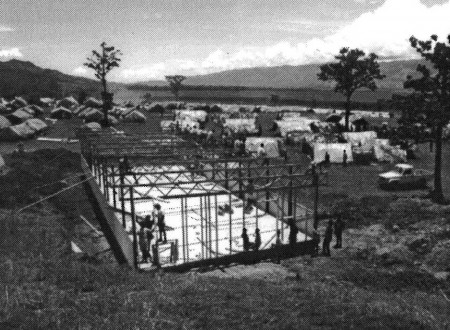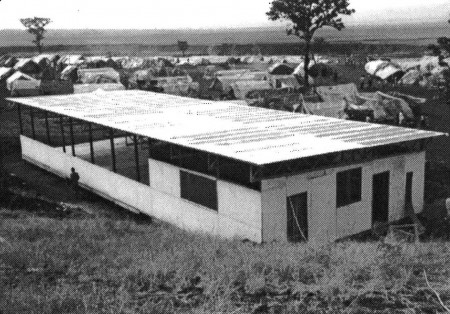Those of us in Madang awoke to find the room moving and shaking. It was about 4:30 in the morning on October 25, 1993 and we were experiencing another earthquake. Papua New Guinea is located on what is called the “Ring of Fire” , an area circling the Pacific Ocean where volcanoes and earthquakes are common. In fact, earthquakes are so common that few people here take more than a passing notice of them, even the large ones. However, this one soon proved to be an exception.
About fifty miles from Madang, deep in the Finisterre Mountains, the quake had struck with deadly force. Houses were demolished, trees fell, large cracks opened in the earth, and entire mountain sides broke loose and plummeted into the valleys below. In a few places these land slides blocked rivers and covered entire villages. Even in areas where there were no landslides, the earth was loosened to the point where it was likely that the next big quake would bring it down as well. Therefore, due to the instability of the ground and the possibility of large aftershocks coming over the next few weeks, the provincial authorities decided to evacuate the residents of a number of villages and hamlets to lower ground until the danger could be assessed and until the aftershocks ceased.
A large refugee center was established for these displaced people at Gusap, about three hours from Madang by’ road. By the time the evacuation was completed, nearly 5,000 people were crowded into the Gusap care center. Up to that time these people had been subsistence farmers and hunters. With the evacuation, however, they had left behind their homes, their gardens, and all they normally relied on for their livelihood. They were completely dependent on the generosity of the government and private agencies. On the Sunday following the earthquake, Madang’s Member of Parliament, Sir Peter Barter, put out an appeal for assistance from the local community. One of the projects he mentioned needing help with was the construction of a community center to serve the needs of the people.

Jan Messersmith, PBT’s Administrator of Data Processing, immediately started thinking about how PBT could be involved in the planning and construction of the building. At the time Dave Rathbun, a carpenter, was on staff in Madang. Jan also was willing to take time out to work on this project. Elated, Sir Peter gave Jan and Dave the go ahead to proceed. They were to design the building and, on the basis of that design, purchase the needed materials. It took the two of them four days of hard work to complete the design, purchase the materials, and arrange for transport to the Gusap center. Some of the work, such as building the trusses, was done in Madang, but the bulk would be done on site. Since the nearest hardware store was three hours of hard travel from Gusap, Jan and Dave were careful to make sure that everything needed was sent out on those trucks. No one wanted to make a six hour round trip for some small but essential forgotten item. On Friday, with all the preparations complete, Jan and Dave set out for Gusap. Shortly before they arrived at the camp they were surprised to see a tractor with an end loader coming the other direction. They stopped the driver and he agreed to return to the camp to level the building site. The carpentry crew arrived right on time and Jan and Dave were pleased to find these men very capable. At the Gusap church service on Sunday Jan requested that any trained carpenters from the camp also come and help. A dozen young men came forward who had been away to town at one time or another and had received training. With a crew that large, construction progressed quickly.
Sir Peter had requested that the building be designed to be taken apart and moved when the center was shut down. With that in mind, Dave designed the building to be to be constructed from three small connected buildings. Later, when the people returned to their villages, the community center could be disassembled and the three smaller buildings taken with them for use as medical facilities and meeting houses. While this made the construction more complicated, all concerned were pleased to be doing something that would have lasting benefits for the people.

On Wednesday morning Jan and Dave had to return to Madang for a meeting. They were able to report to the group that when they left Gusap the corrugated iron roof was being nailed on and that another day or two would see the building completed. Dave returned to the site on Thursday to assist with hanging doors and other finishing work. Except for some plumbing and electrical work, the building was finished on Friday, just one week after construction started. Often when we talk about the work of PBT, we talk about the challenges and rewards of bringing the Gospel to people in their own languages. The gospel, however, is not just concerned with people’s spiritual needs. Jesus Himself said that the mark of His disciples would be that they would care for the physical needs of the disadvantaged. Therefore, our ministry here is manifested in ways other than just translation. Swinging a hammer or digging a post hole may not seem too spiritual, but it is a concrete manifestation of the love that Jesus has for his children.